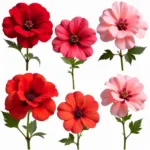Ocher color, a warm and earthy pigment, has captivated artists and decorators for centuries. From prehistoric cave paintings to modern interior design, its versatile hues have left an indelible mark on human expression. But what exactly is ocher color, and what makes it so enduring?
Unmasking the Earthy Hues of Ocher
Ocher is a natural pigment derived from iron oxide and clay. Its color ranges from a pale, yellowish-brown to a deep, reddish-orange, depending on the hydration and oxidation levels of the iron oxide. This natural variation results in a rich palette of shades, each with its own unique character. The name “ocher” itself originates from the Greek word “ōkʰra,” meaning “pale yellow,” although the pigment encompasses a much broader spectrum of colors. You can find more about colors that start with o in a color that starts with o.
 Various Shades of Ocher
Various Shades of Ocher
A Journey Through Time: Ocher in History
Ocher’s history is intertwined with human civilization. Our ancestors used it as a paint for cave art, decorating their dwellings with vibrant depictions of animals and everyday life. The Lascaux cave paintings in France, for example, showcase the early use of ocher, demonstrating its durability and lasting power. Later, ocher became a crucial pigment in ancient Egyptian art, adorning tombs and temples with its warm, earthy tones. This historical significance underscores ocher’s enduring appeal. Learn how to use these colors to color plaster by visiting how to color plaster.
What Color is Ocher Used For?
From ancient times to the present day, ocher continues to be a popular choice for various applications. Its natural, earthy hues are ideal for creating a warm and inviting atmosphere in interior design. Ocher pigments are also used in cosmetics, paints, and dyes, demonstrating their versatility and adaptability.
Understanding Ocher’s Different Shades
Ocher is not a monolithic color. Its diverse range of shades adds to its appeal and allows for a wide range of artistic expressions. Yellow ocher, with its light and airy hue, evokes a sense of warmth and sunshine. Red ocher, a darker, more intense shade, brings a touch of drama and earthiness. Burnt ocher, created by heating yellow ocher, offers a rich, reddish-brown tone reminiscent of autumn leaves. Understanding these different shades allows you to use ocher effectively in your creative endeavors. For a deeper understanding of the color, check out what color is ocher. You might also be interested in knowing what color is a brown bear.
What is the Difference Between Ocher and Ochre?
While both “ocher” and “ochre” refer to the same pigment, “ochre” is the more common spelling in British English, while “ocher” is preferred in American English. The difference in spelling doesn’t affect the color itself. If you’re looking for more information about the color ocher, you can find a detailed explanation at what is the color ocher.
Conclusion
Ocher, a timeless pigment with a rich history, continues to inspire artists and designers. Its warm, earthy hues and diverse range of shades offer endless possibilities for creative expression. From ancient cave paintings to modern interior design, ocher color remains a testament to the enduring power of nature’s palette.
FAQ
-
What is the chemical composition of ocher?
Ocher is primarily composed of hydrated iron oxide (FeO(OH)) mixed with clay and other minerals. -
Is ocher toxic?
Natural ocher is generally non-toxic. However, synthetic versions may contain harmful additives. -
Can I mix ocher with other pigments?
Yes, ocher can be mixed with other pigments to create a wide range of colors. -
How can I make burnt ocher?
Burnt ocher is created by heating yellow ocher, which dehydrates the iron oxide and changes its color. -
Where can I buy ocher pigments?
Ocher pigments are available from art supply stores, paint stores, and online retailers. -
What are some common uses of ocher in art?
Ocher is commonly used in oil painting, watercolor painting, and fresco painting. -
How lightfast is ocher?
Ocher is considered a highly lightfast pigment, meaning it doesn’t fade easily when exposed to light.
Need help with color selection or painting projects? Contact us at 0373298888, email [email protected], or visit us at 86 Cau Giay, Hanoi. We have a 24/7 customer service team.
